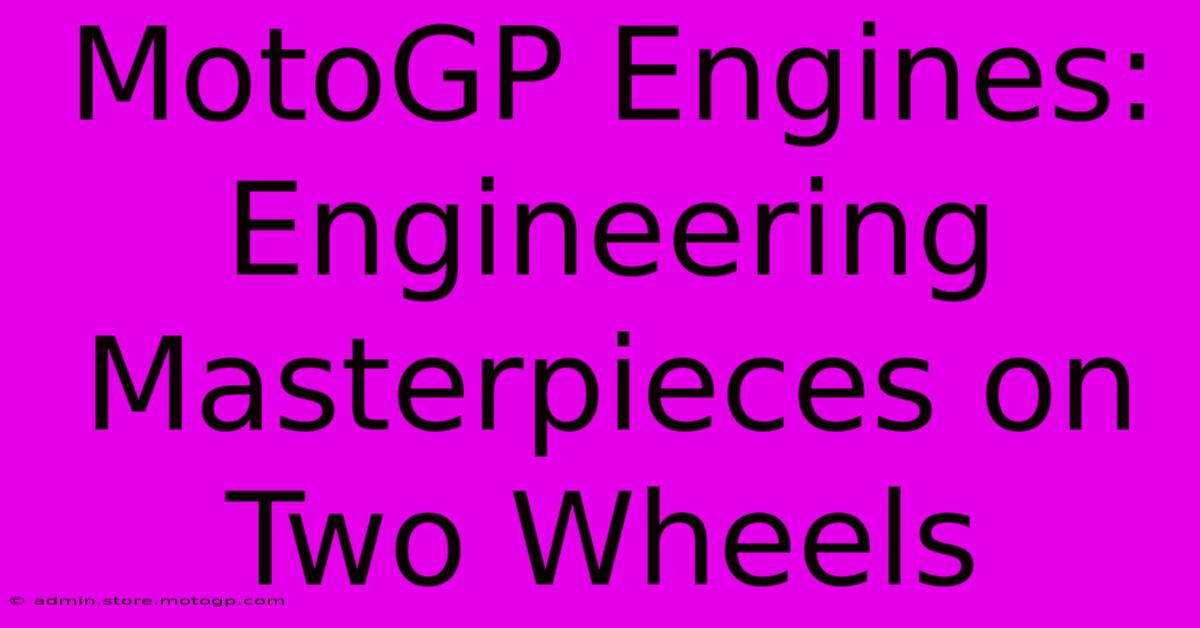MotoGP Engines: Engineering Masterpieces On Two Wheels

Table of Contents
MotoGP Engines: Engineering Masterpieces on Two Wheels
MotoGP. The name conjures images of screaming engines, breathtaking speeds, and the pinnacle of motorcycle racing. But behind the spectacle lies a world of cutting-edge engineering, and at its heart, the MotoGP engine. These aren't your average motorcycle motors; they are highly specialized, meticulously crafted powerhouses representing the absolute peak of internal combustion engine technology. This article delves into the intricacies of these incredible machines, exploring their design, technology, and the relentless pursuit of performance that defines them.
The Heart of the Beast: Engine Specifications and Design
MotoGP engines are strictly regulated, currently featuring four-stroke, 1000cc prototypes. This seemingly simple description belies the immense complexity hidden within. These aren't mass-produced units; each engine is a bespoke work of art, meticulously designed and built by expert engineers.
Key Features:
- High RPM Capabilities: These engines are designed to rev incredibly high, typically exceeding 16,000 rpm. This high rev limit is crucial for extracting maximum power from the relatively small displacement.
- Lightweight Construction: Every gram counts in MotoGP. Extensive use of lightweight materials like titanium, magnesium, and carbon fiber is essential for minimizing weight and optimizing the bike's handling.
- Sophisticated Electronics: Modern MotoGP engines rely heavily on advanced electronics. Engine control units (ECUs) manage fuel injection, ignition timing, and other crucial parameters, constantly optimizing performance based on track conditions and rider input. This includes features like traction control, wheelie control, and launch control.
- Aerodynamic Integration: Engine design isn't solely about power; it's also about aerodynamics. The engine's shape and placement contribute to the overall aerodynamic efficiency of the motorcycle, playing a crucial role in top speed and cornering stability.
- High-Performance Components: Every component, from the pistons and connecting rods to the crankshaft and valves, is engineered for maximum strength, durability, and performance under extreme stress. Materials science plays a significant role, with manufacturers constantly pushing the boundaries of what's possible.
The Technology Behind the Power
The technology employed in MotoGP engines is constantly evolving. Manufacturers are constantly innovating, searching for any marginal gain that could give them an edge on the track. Here are some key technological advancements:
- Pneumatic Valves: Some teams are experimenting with pneumatic valve actuation systems, enabling faster valve opening and closing speeds, leading to improved breathing and power output.
- Seamless Shift Technology: This allows riders to shift gears without closing the throttle, providing smoother acceleration and improved lap times.
- Advanced Materials: The ongoing development and implementation of new, high-performance materials, such as exotic alloys and carbon fiber composites, continuously improves engine durability and reduces weight.
The Pursuit of Perfection: Ongoing Development and Innovation
The development of a MotoGP engine is a continuous process. Teams employ sophisticated data acquisition systems to monitor engine performance during races and testing, enabling engineers to fine-tune engine settings and identify areas for improvement. Computational fluid dynamics (CFD) and finite element analysis (FEA) are heavily used in the design process, allowing virtual testing and optimization before physical prototypes are even built. This relentless pursuit of perfection is what sets MotoGP engines apart.
In Conclusion:
MotoGP engines represent the pinnacle of motorcycle engine technology. They are a testament to human ingenuity and the relentless pursuit of performance. The combination of sophisticated engineering, advanced materials, and cutting-edge technology results in incredible machines that push the boundaries of what's possible. Their complexity and power continue to inspire awe and fascination in the world of motorsport. As technology advances, the evolution of these engineering masterpieces promises even more thrilling races and technological breakthroughs in the years to come.

Thank you for visiting our website wich cover about MotoGP Engines: Engineering Masterpieces On Two Wheels. We hope the information provided has been useful to you. Feel free to contact us if you have any questions or need further assistance. See you next time and dont miss to bookmark.
Featured Posts
-
Moto Gp Qualifying On The Brink Of Glory
Feb 20, 2025
-
Cota F1 General Admission Deals You Cant Miss
Feb 20, 2025
-
Moto2 Standings 2025 The Race Is On
Feb 20, 2025
-
Moto Gp Starting Grid Experience The Thrill
Feb 20, 2025
-
Unbeatably Fast Airport Transfers The F1 Shuttle
Feb 20, 2025
